Discover the beauty and diversity of sea plants with our guide to 30 amazing ocean plant species. Explore the ocean floor and learn about the names of sea plants that live in the ocean and their importance to marine ecosystems.
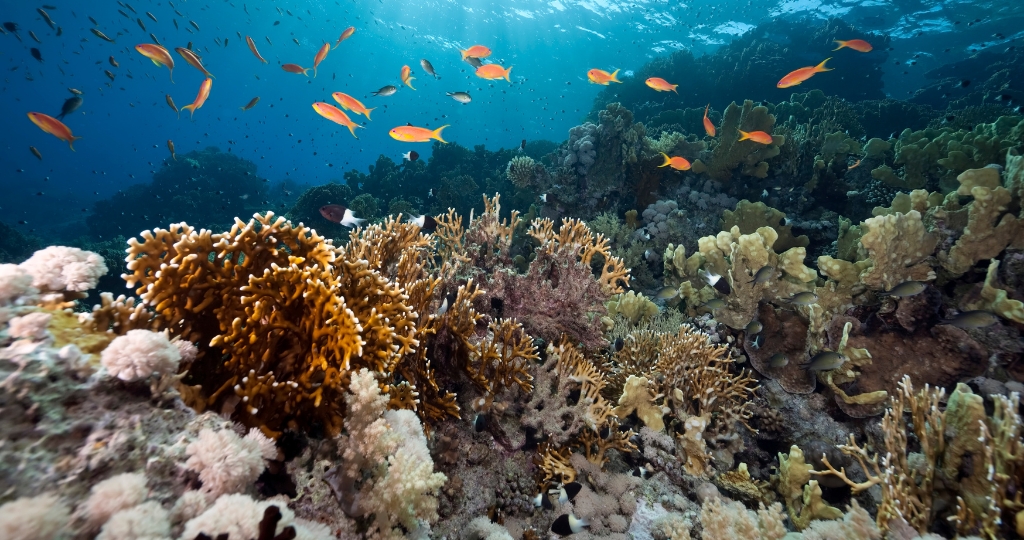
The ocean is home to a vast array of incredible and diverse plant life, from tiny single-celled algae to towering seaweed forests.
These amazing sea plants not only provide vital habitat and food for countless marine animals but also offer a fascinating glimpse into the complex and beautiful world of the ocean.
In this list, we’ll explore some of the most fascinating and awe-inspiring sea plants, each with its unique characteristics, adaptations, and ecological roles.
Get ready to dive into the wondrous world of sea plants and discover the incredible diversity of life that calls the ocean home.
What are Sea Plants (Ocean Plants)?
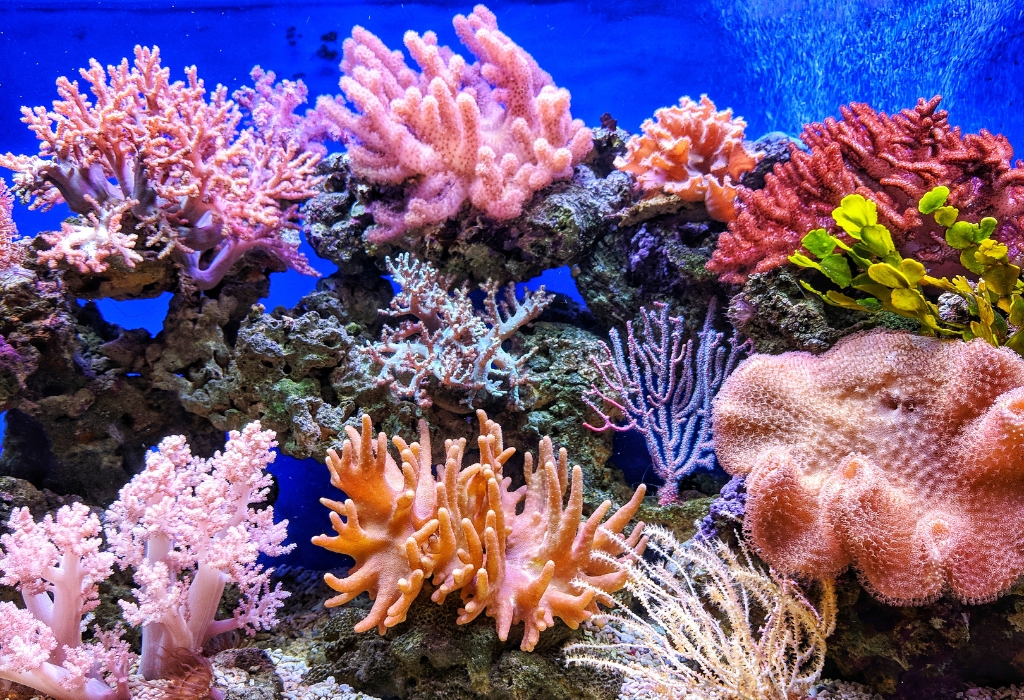
Sea plants are a diverse group of organisms that live in saltwater environments such as oceans, seas, and estuaries.
They include a wide range of species, from microscopic single-celled algae to large, complex seaweeds that can form dense underwater forests.
Sea plants are an essential component of marine ecosystems, providing habitat and food for a wide variety of marine animals, from tiny plankton to massive whales.
They also play an important role in regulating the Earth’s climate and producing oxygen through the process of photosynthesis.
Some sea plants are even used by humans in a variety of products, including food, medicine, and cosmetics.
Overall, sea plants are a vital and fascinating part of the marine world that contribute to the health and well-being of both marine and terrestrial ecosystems.
30 Amazing Sea Plants that Live in the Ocean!
Here are the 30 amazing living plants in the ocean.
1. Sea Anemone
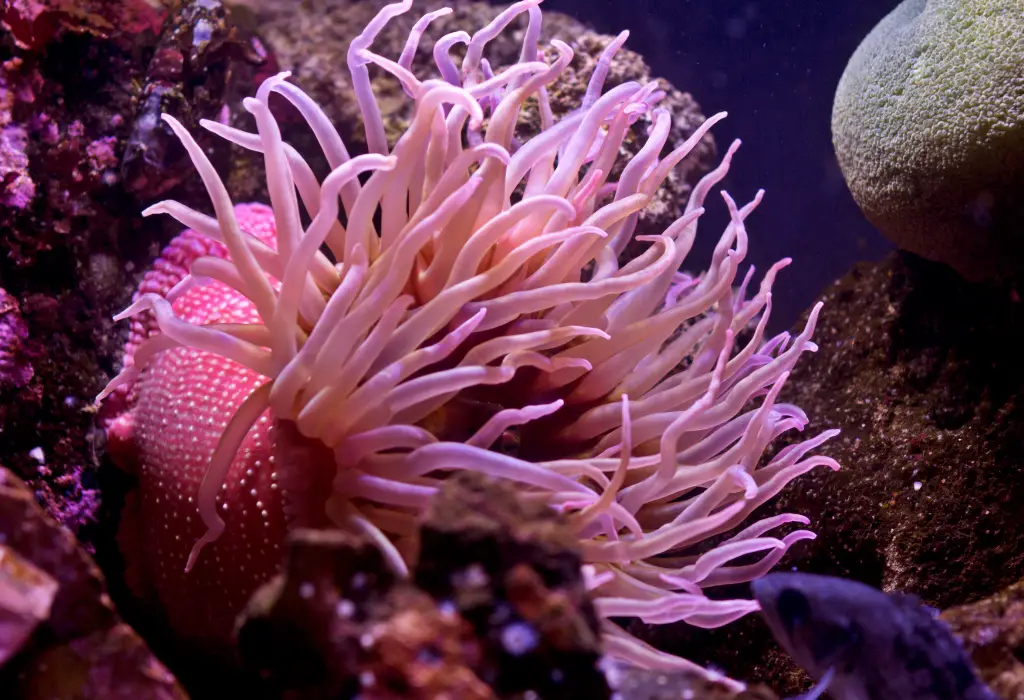
Sea anemones are marine animals belonging to the phylum Cnidaria, found in oceans worldwide. These sea plants have a cylindrical body with tentacles surrounding a central mouth, resembling terrestrial flowers.
The tentacles have stinging cells used to capture and immobilize prey such as small fish and invertebrates. Sea anemones are important in marine ecosystems, providing habitat and shelter for a variety of fish and invertebrates like clownfish, shrimp, and crabs.
They also help maintain the health of coral reefs by preying on organisms that can damage the coral.
2. Sea fan (Gorgonia)
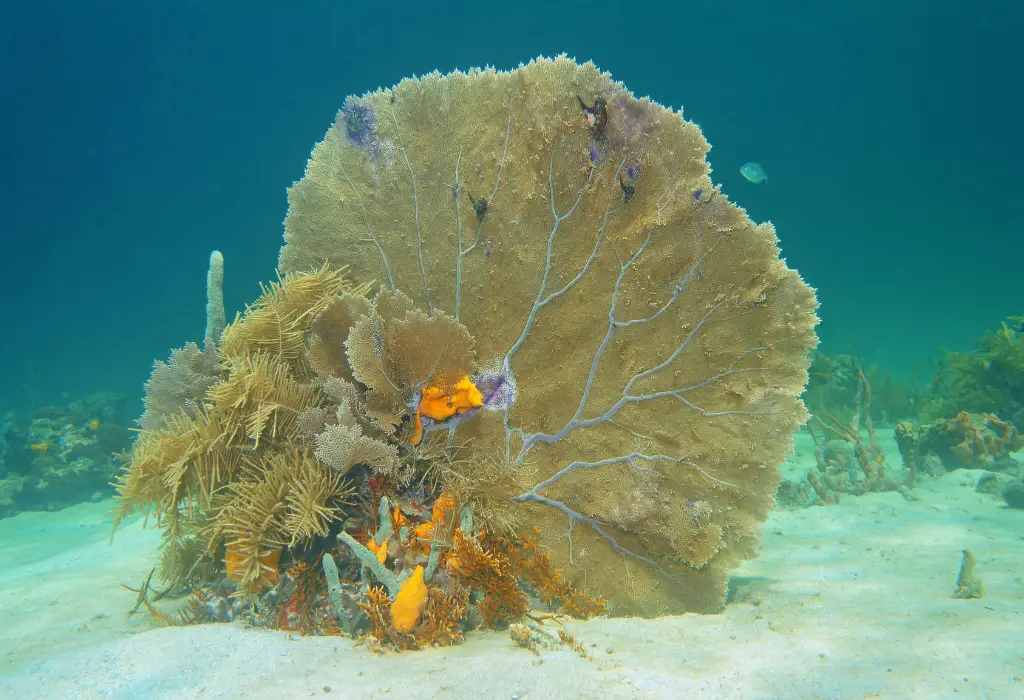
Sea fan (Gorgonia) is a type of soft coral that is found in shallow tropical waters around the world. It is known for its beautiful, fan-shaped appearance, which is created by the delicate branching structure of its colony. Sea fans are also called gorgonian sea fans or simply gorgonians.
Sea fans come in a variety of colors, including pink, purple, yellow, orange, and red, and they can grow up to several meters in size. They are composed of thousands of tiny polyps, which work together to create the intricate network of branches that make up the fan.
Sea fans are an important part of many marine ecosystems. They provide a habitat for a wide range of organisms, including small fish, crustaceans, and other invertebrates. They also play a crucial role in the overall health of coral reef ecosystems, as they help to filter nutrients from the water and provide a source of food for many reef-dwelling organisms.
3. Kelp (Laminariales)

Brown seaweed known as Kelp (Laminariales) thrives in cool, nutrient-rich waters across the globe, growing in underwater forests that can reach towering heights of up to 130 feet.
Kelp serves as a crucial habitat and source of sustenance for diverse marine organisms like sea urchins, fish, and sea otters.
Additionally, humans harvest Kelp for a variety of applications, including cosmetics, fertilizer, and food.
4. Giant Plumose Anemone

Metridium giganteum, also known as Giant Plumose Anemone, is a large and colorful sea anemone found along the Pacific coast of North America.
Its long, feathery tentacles extend from its cylindrical body, giving it a plumage-like appearance.
Giant Plumose Anemone is a powerful predator, using its stinging tentacles to capture and immobilize small fish, crabs, and other invertebrates. It can also retract its tentacles and close its body into a tight ball to protect itself from predators like sea stars.
Despite its fearsome reputation, Giant Plumose Anemone is an important part of the marine ecosystem, providing habitat and shelter for various fish and invertebrates. It also helps filter and purify the surrounding water, contributing to the health and balance of the ecosystem.
5. Red Grape Algae (Gloiopeltis Tenax)
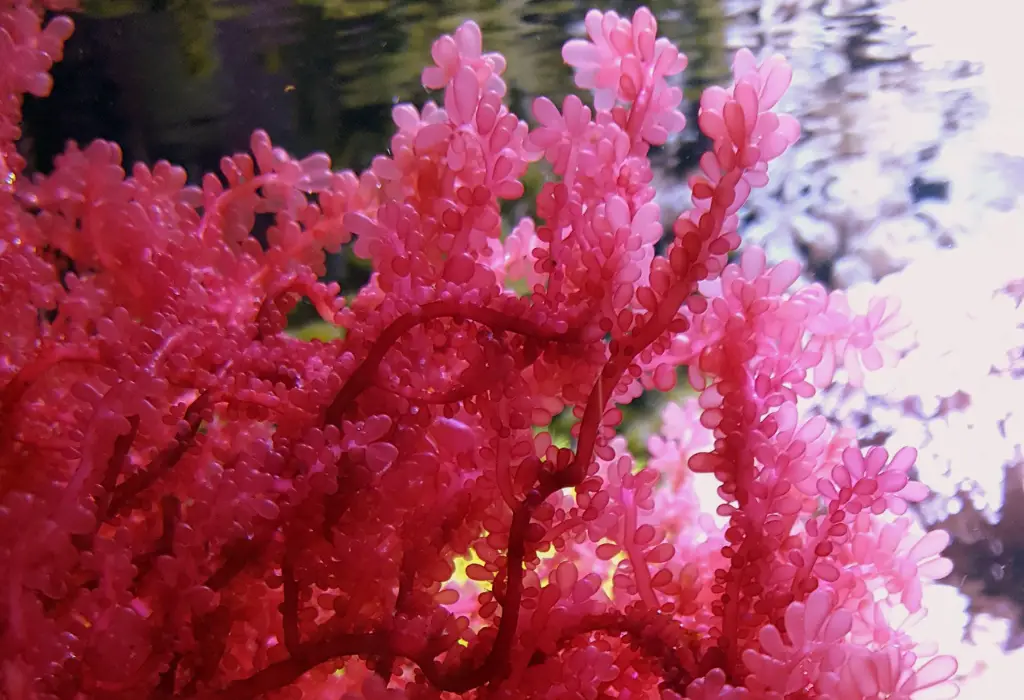
Red grape algae, also known as Gloiopeltis tenax, is a species of red algae that is found in the intertidal and subtidal zones of the Pacific Northwest. It gets its name from its grape-like appearance, with a series of round or oblong bladders that are filled with gas and help keep the plant buoyant.
Red grape algae can grow up to 50 centimeters long and is typically found growing on rocks or other hard substrates. It is an important food source for a variety of marine organisms, including sea urchins, crabs, and snails. It is also used in traditional Chinese medicine to treat a variety of ailments, including coughs, asthma, and constipation.
Red grape algae is an important part of the marine ecosystem, providing habitat and food for a variety of organisms. However, it is also vulnerable to a range of threats, including pollution, habitat loss, and overharvesting.
6. Giant Kelp (Macrocystis Pyrifera)

Giant kelp, scientifically known as Macrocystis pyrifera, is an absolutely fascinating marine organism that belongs to the brown algae family. It is the largest species of marine algae and can grow at an astonishing rate of up to two feet per day, forming dense underwater forests that provide shelter and habitat for a plethora of marine species.
This majestic seaweed is found in the cold, nutrient-rich waters of the Pacific Ocean, from Alaska to southern California, and from southern South America to Australia. It grows from the ocean floor, anchored to rocks by a strong, flexible stem called a stipe, which can reach up to 100 feet in length.
The fronds of giant kelp are long and flat, resembling the leaves of a tree, and can grow up to 150 feet in length. The fronds have a unique structure that allows them to absorb sunlight and nutrients from the water efficiently. These fronds are not only incredibly beautiful to observe but also provide crucial habitat and shelter for various marine animals, including sea otters, fish, crustaceans, and invertebrates.
Giant kelp plays a critical role in regulating the Earth’s climate as it absorbs large amounts of carbon dioxide from the atmosphere, and it has been proposed as a potential solution for mitigating climate change. Moreover, this remarkable plant is also used for several human purposes, such as fertilizers, animal feed, and even biofuel production.
7. Soft Coral
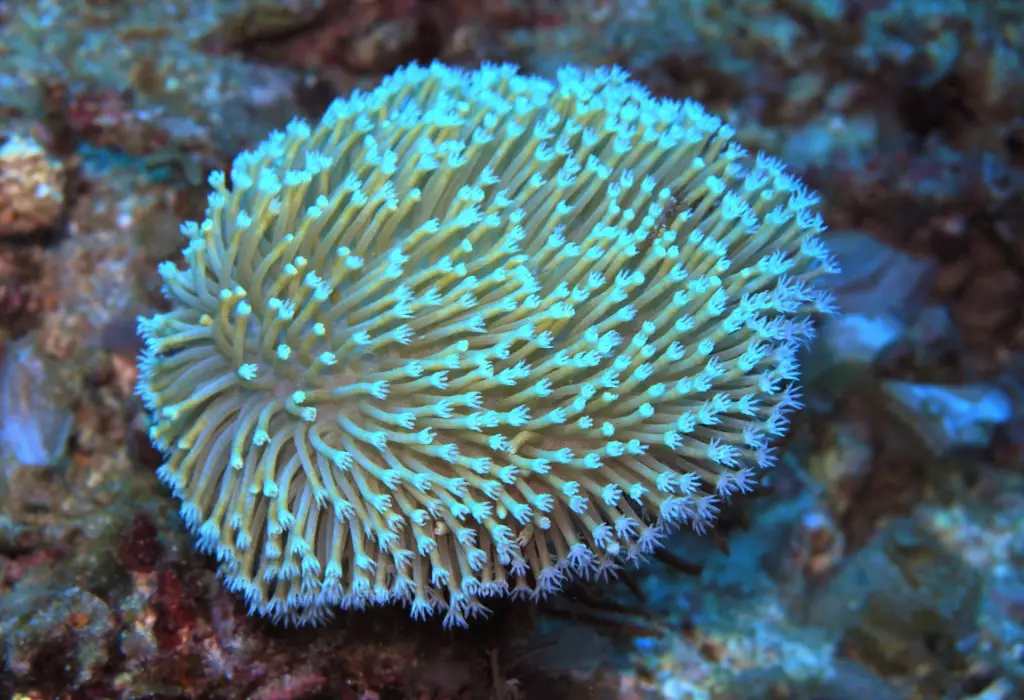
Soft corals are a diverse group of marine animals that appear flexible and are often confused with plants. They can be found in tropical waters and are known for their vibrant colors.
Unlike hard corals, soft corals have an internal skeleton composed of protein and collagen, allowing them to move with the ocean currents. Soft corals come in a variety of shapes and sizes, providing shelter and habitat to different marine animals.
They also contribute to the health of coral reef ecosystems by filtering and purifying the surrounding water.
8. Open Brain Coral
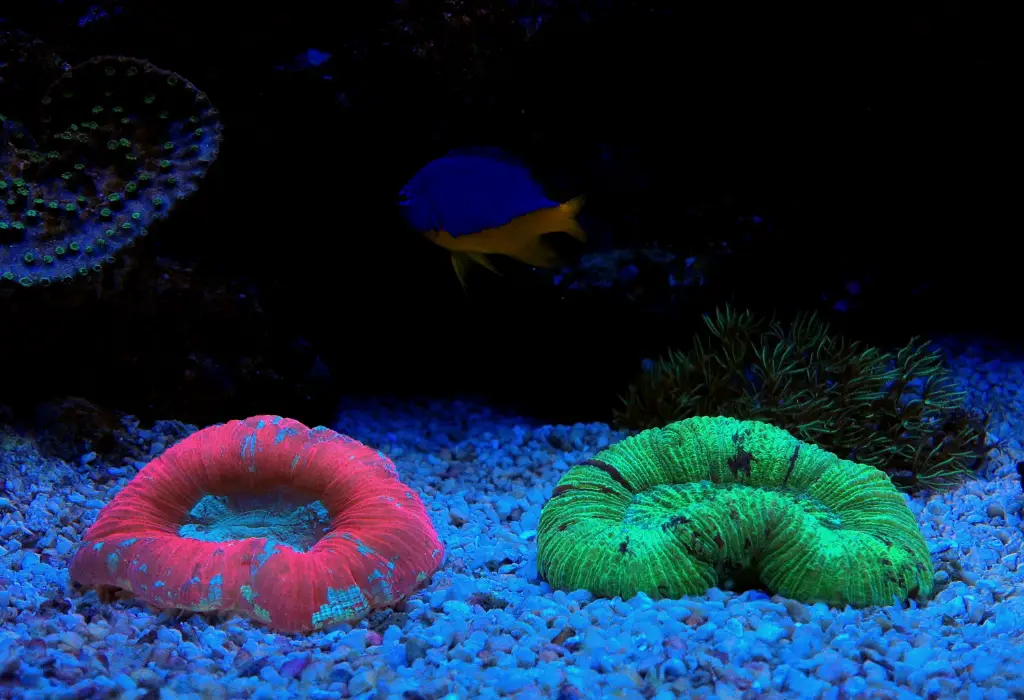
The species Trachyphyllia geoffroyi, also known as Open Brain Coral, is a large and solitary coral found in the Indo-Pacific region.
It is called Open Brain Coral because of its brain-like appearance with folds and ridges. This coral is important to coral reef ecosystems because it provides habitat and shelter for various marine animals.
Open Brain Coral feeds on plankton and other small organisms at night and withdraws into its skeleton during the day to avoid exposure to bright sunlight and predators. It is also popular in the aquarium trade because of its stunning appearance and ease of care.
9. Red Sea Whip

Red Sea Whip, also known as Erythropodium caribaeorum, is a type of red algae found in the Caribbean Sea and Gulf of Mexico. It is a branching seaweed that can grow up to 1 meter in height and has a bright red color.
Red Sea Whip serves as an important habitat for many marine animals, such as shrimp, crabs, and juvenile fish, providing shelter and a source of food. It also has potential for use in biomedical research due to its unique chemical compounds that have shown antimicrobial and antifungal properties.
However, it is important to note that harvesting of this species is regulated and requires a permit to ensure sustainable use.
10. Waterwheel Plant (Aldrovanda Vesiculosa)
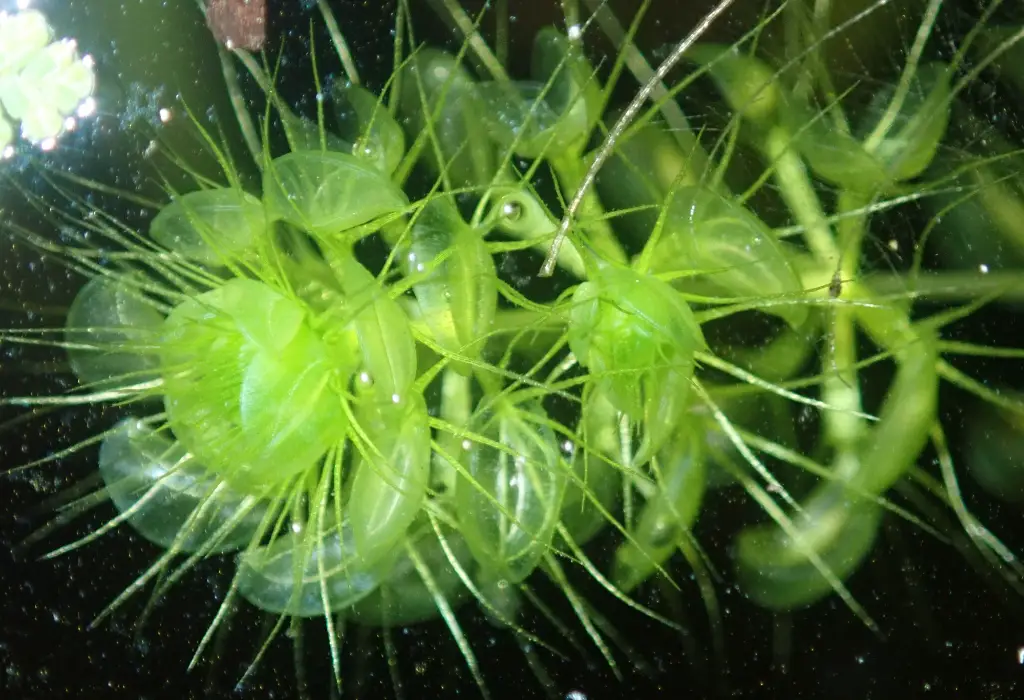
Aldrovanda vesiculosa, commonly known as Waterwheel Plant, is a carnivorous aquatic plant that captures and digests small aquatic animals like water fleas and mosquito larvae.
The plant has thin, green leaves arranged in a circular, wheel-like pattern, covered in hair-like structures that aid in capturing prey.
Waterwheel Plant thrives in nutrient-poor environments such as shallow, stagnant ponds and wetlands by supplementing its diet with the nutrients it gains from the animals it captures and digests.
11. Seagrass (Zosteraceae)

Seagrass, scientifically known as Zosteraceae, is a type of flowering plant that grows in shallow coastal waters around the world. It is a vital component of marine ecosystems and plays a critical role in maintaining the health and well-being of our oceans.
Seagrass is a highly adaptable plant that can thrive in a wide range of environments, from the warm, sunlit waters of the tropics to the cooler, more temperate waters of the North Atlantic. It has long, ribbon-like leaves that grow from underground rhizomes and can form dense meadows on the ocean floor. These meadows provide important habitat and shelter for a wide range of marine organisms, including fish, crabs, and shellfish.
In addition to its ecological importance, seagrass also has numerous benefits for humans. It helps to prevent shoreline erosion by stabilizing sediment, and it can help to improve water quality by filtering pollutants and excess nutrients from the water. Seagrass also plays an important role in mitigating climate change by sequestering carbon from the atmosphere.
12. Rockweed (Fucus)
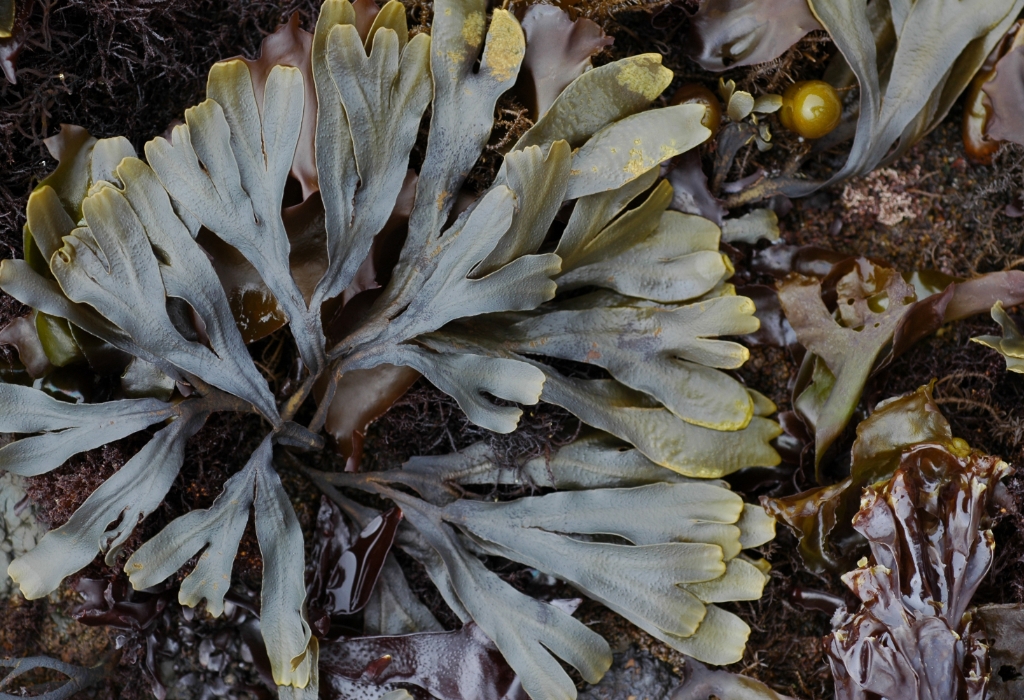
Rockweed, also known as Fucus, is a type of brown algae that grows in intertidal zones along rocky coastlines. It has a unique and distinct appearance, with air bladders that help it stay afloat and long, ribbon-like fronds that can reach up to 2 meters in length.
Rockweed plays an important ecological role in the marine environment, providing habitat and food for a variety of marine organisms, including snails, crabs, and sea urchins. It also helps to stabilize shorelines by absorbing wave energy and reducing erosion.
Rockweed has been used for centuries in traditional medicine to treat a variety of ailments, and is also used in the production of cosmetics and other products.
13. Gracilaria
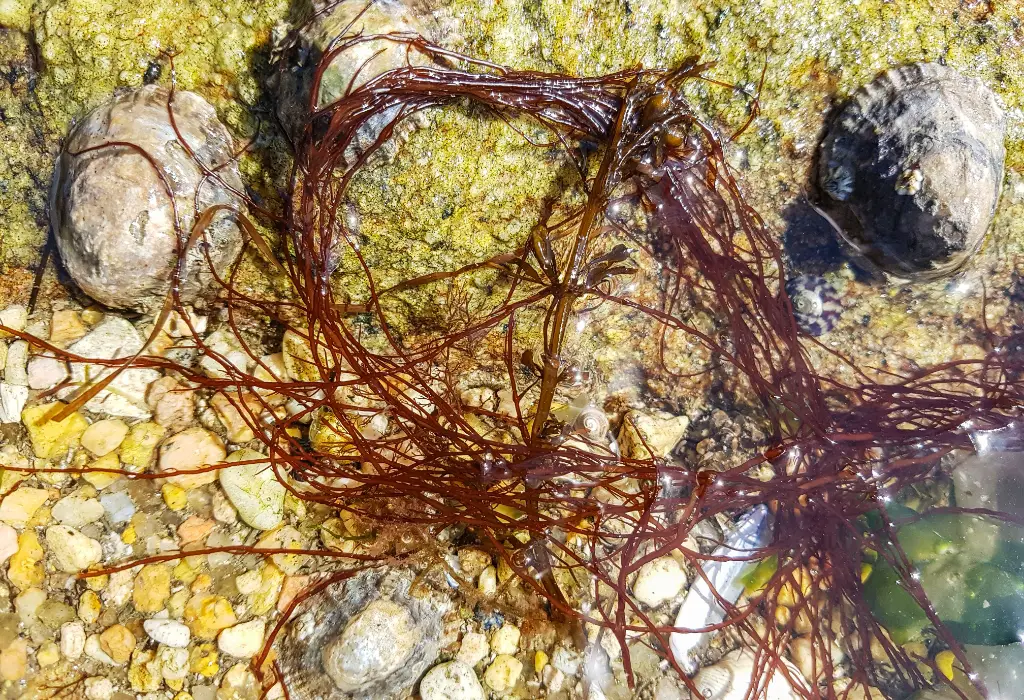
Red seaweed known as Gracilaria, found in tropical and subtropical waters globally, is a significant food source for marine creatures like sea urchins and fish.
It has a unique and delicate appearance, with branching fronds that can reach up to 30 centimeters in length.
It also helps to maintain water quality by removing excess nutrients from the water. Gracilaria is also used by humans in multiple applications, including food, pharmaceuticals., medicine, and cosmetics.
14. Sargassum
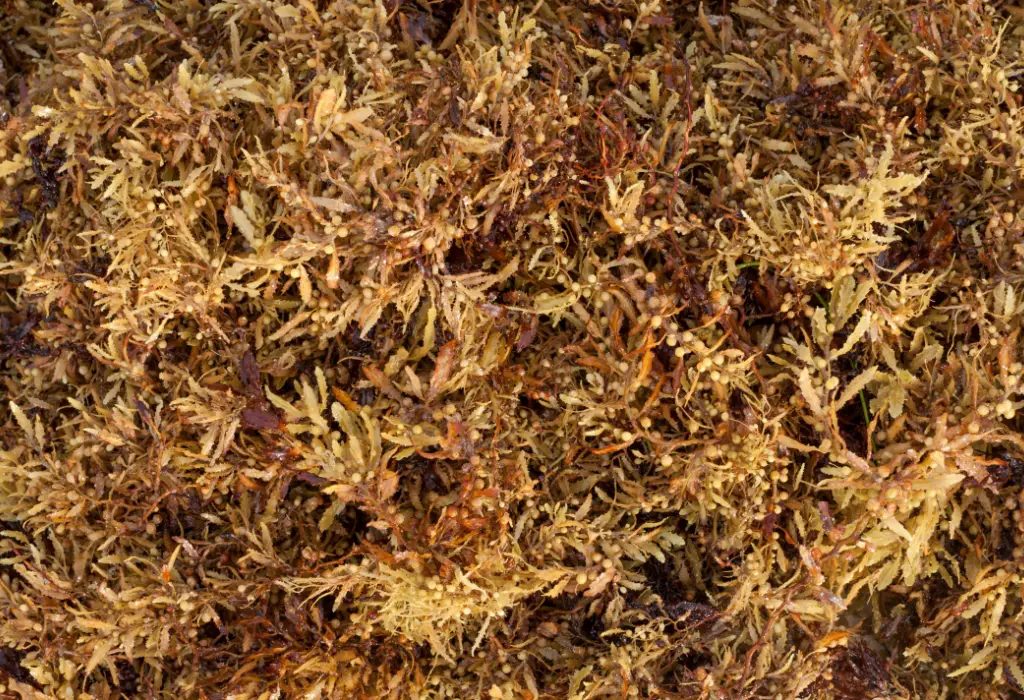
Brown macroalgae known as Sargassum often floats in large mats or patches in the open ocean, particularly in the Sargasso Sea in the Atlantic Ocean.
With its distinctive, bushy appearance, it can grow up to several meters in length, serving as a vital habitat for various marine creatures like fish, turtles, and birds.
Additionally, humans use Sargassum in a range of applications, including fertilizer and food.
15. Halimeda
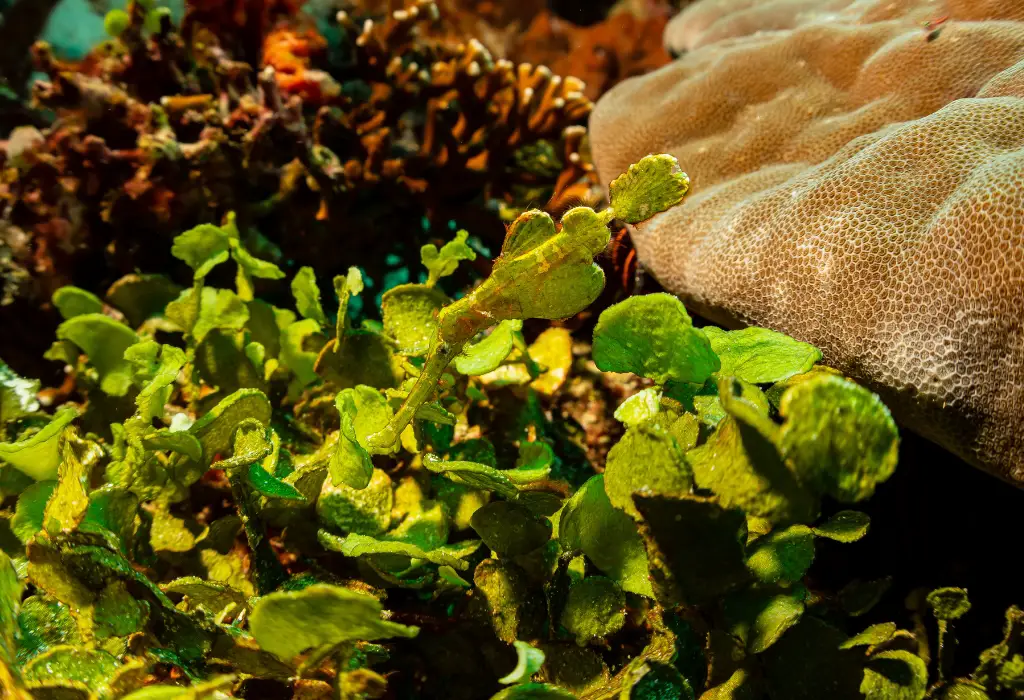
Halimeda is a genus of green algae that is commonly found in tropical and subtropical waters around the world. It is known for its distinctive, calcified structure that gives it a crunchy texture.
Halimeda is an important contributor to the marine food chain, providing food and habitat for a variety of marine organisms, including herbivorous fish and invertebrates. It is a critical source of calcium carbonate that contributes to building coral reefs.
Halimeda is also valuable to humans, as it is sometimes used as a calcium supplement and is sometimes used in the production of biofuels.
16. Caulerpa
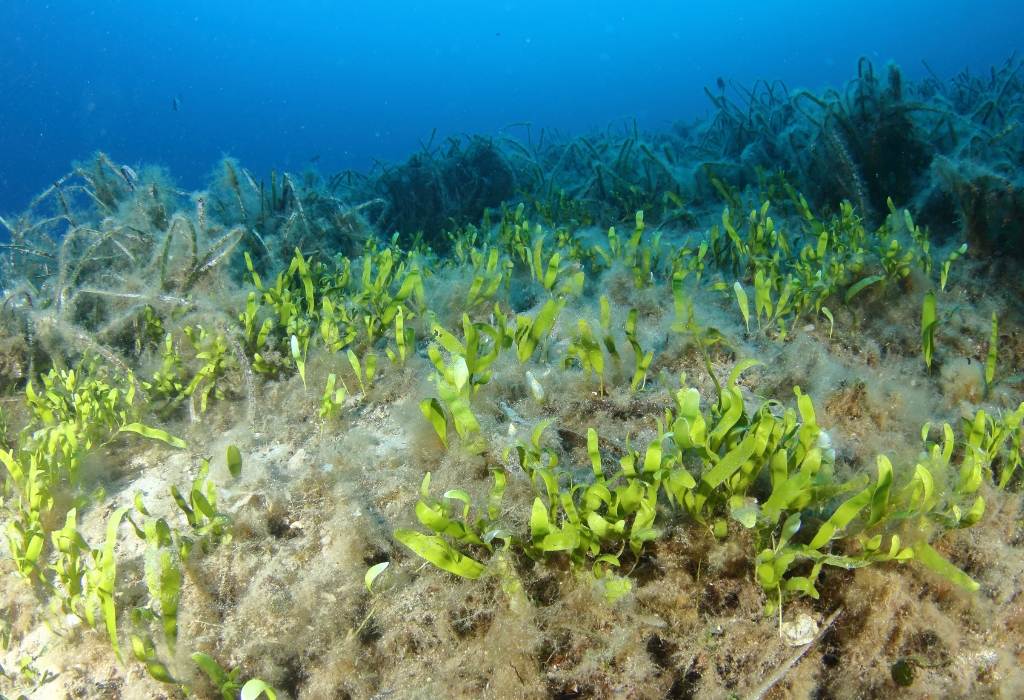
Caulerpa is a genus of green algae that is commonly found in tropical and subtropical waters around the world. It is known for its distinctive, leafy fronds that can grow up to several feet long.
Caulerpa is an important component of many marine ecosystems, providing habitat and food sources for a variety of marine organisms, including sea turtles and herbivorous fish.
Caulerpa is also valuable to humans, as it is sometimes used in the production of food and cosmetics.
17. Chondrus crispus (Irish moss)
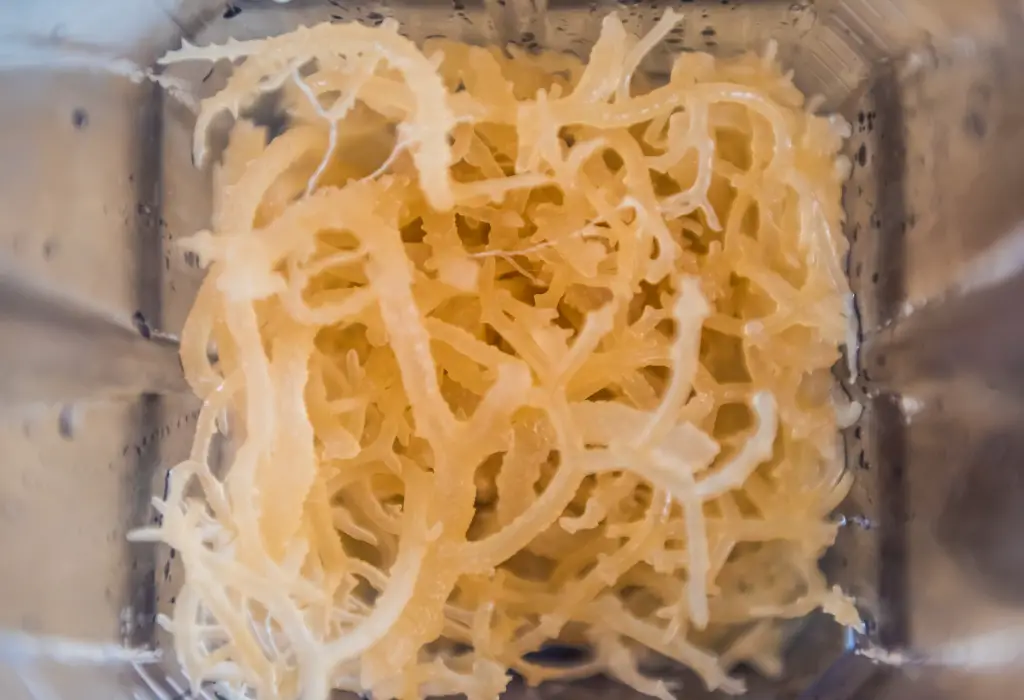
Chondrus crispus, commonly known as Irish moss, is a species of red algae that is found in cold waters throughout the world.
It is known for its tough, leathery texture and its ability to thrive in harsh conditions. Irish moss is an important component of many marine ecosystems, providing habitat and food sources for a variety of marine organisms, including sea urchins and snails.
Irish moss is also valuable to humans, as it is used in a variety of products, including food, cosmetics, and medicine. It is particularly known for its high content of carrageenan, a substance that is used as a thickener and emulsifier.
18. Red algae (Rhodophyta)

Red algae, also known as Rhodophyta, are a diverse group of seaweeds that can be found in almost every ocean around the world.
They range in size from tiny, unicellular organisms to large, multicellular species that can form dense underwater forests. Red algae get their name from their red pigments, which give them their distinctive color.
These sea plants are an important source of food and habitat for a variety of marine animals, including fish, snails, and sea urchins. Some red algae species are also used in the production of food products, such as carrageenan, which is a common thickening agent used in many processed foods.
Red algae are adapted to life in the marine environment and can thrive in a variety of conditions, from shallow, rocky shorelines to deep, dark ocean trenches.
They are also able to withstand extreme temperatures and fluctuations in water chemistry. While many species of red algae are considered beneficial to the marine ecosystem, some can also be harmful. Certain types of red algae, such as the red tide species, can produce toxins that can have negative effects on the health of marine animals and even humans.
19. Green algae (Chlorophyta)

Green algae, also known as Chlorophyta, are a group of sea plants that are closely related to land plants. They can be found in a variety of marine environments, from shallow tide pools to deep ocean trenches, and range in size from small, unicellular species to large, multicellular seaweeds.
Green algae get their name from their green pigments, which are similar to those found in land plants. They are an important source of food and habitat for many marine animals, including sea turtles and sea urchins. Some species of green algae are also used in the production of food products, such as agar, which is commonly used as a gelling agent in many foods.
Green algae are adapted to life in the marine environment and have a variety of unique adaptations that allow them to survive in different conditions.
For example, some species have the ability to photosynthesize in low light conditions, while others are able to withstand extreme temperatures and salinity levels.
While many species of green algae are considered beneficial to the marine ecosystem, some can also be harmful. Certain types of green algae, such as the species that form large blooms or mats, can have negative effects on the health of marine animals and the overall health of the ecosystem.
20. Codium

Codium, also known as dead man’s fingers, is a genus of green algae that can be found in many marine environments around the world. They are characterized by their distinctive finger-like appearance, which can range in size from just a few centimeters to over a meter in length.
Codium is an important source of food and habitat for a variety of marine animals, including sea urchins and small fish. They are also used in the production of food products, such as sushi, where they are used as a wrapping material for the rice and fish. Codium is adapted to life in the marine environment and can withstand a variety of conditions, including exposure to air during low tide.
They are also able to thrive in areas with high levels of nutrients, such as near agricultural runoff or sewage outflows.
While Codium is generally considered beneficial to the marine ecosystem, it can also become a problem in areas where its growth becomes excessive. When Codium forms dense mats or blooms, it can have negative effects on the health of the ecosystem, such as causing oxygen depletion and disrupting the balance of the food chain.
21. Coralline algae
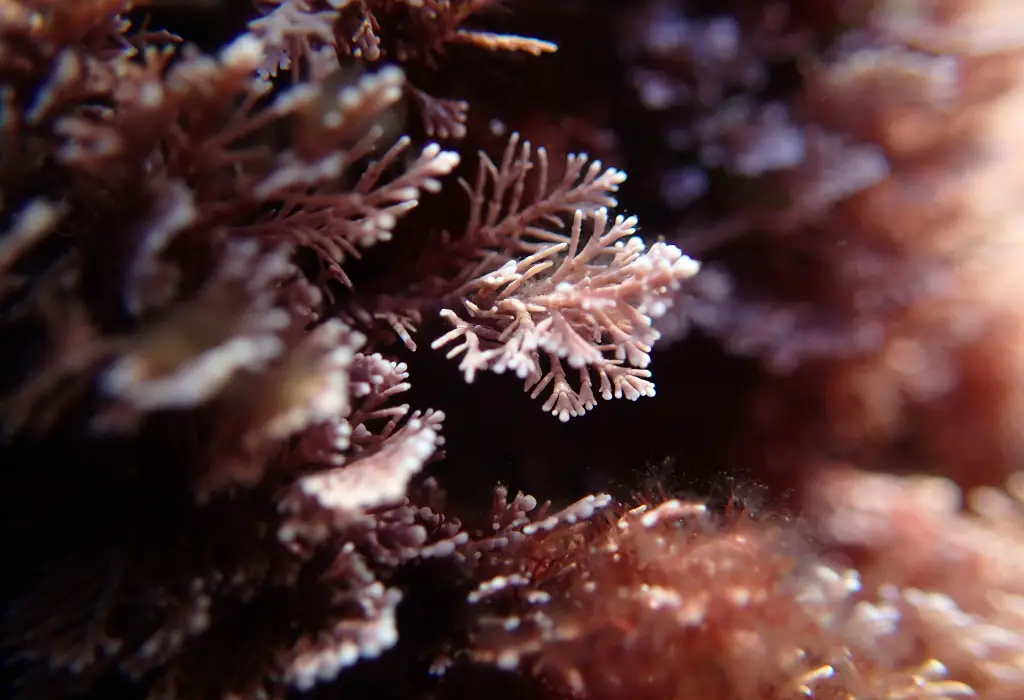
Coralline algae are a group of red algae that are found in marine environments worldwide. They play an important role in reef building and stabilizing marine habitats, as they deposit calcium carbonate in their cell walls, which contributes to the formation of coral reefs.
They are often brightly colored and can form dense, intricate structures that provide important habitat and shelter for a variety of marine organisms.
22. Neptune Grass (Posidonia Oceanica)

The seagrass known as Neptune grass (Posidonia oceanica) is a type of aquatic plant found in the Mediterranean Sea.
It forms vast underwater meadows that serve as a critical habitat for many marine animals, including fish, sea turtles, and seahorses. Neptune grass also has the added benefit of stabilizing the ocean floor and reducing erosion.
23. Oarweed (Laminaria Digitata)

Oarweed, also known as kelp or tangleweed, is a type of brown algae that is found in cold, nutrient-rich waters around the world. It can grow up to several meters in length and has a distinct, leathery texture.
It plays an important ecological role in the marine environment, providing habitat and food sources for a variety of marine organisms. It is also used in a variety of industrial applications, including as a source of alginate, which is used in the production of a variety of products, including food, cosmetics, and pharmaceuticals.
24. Mermaid’s Fan (Udotea)
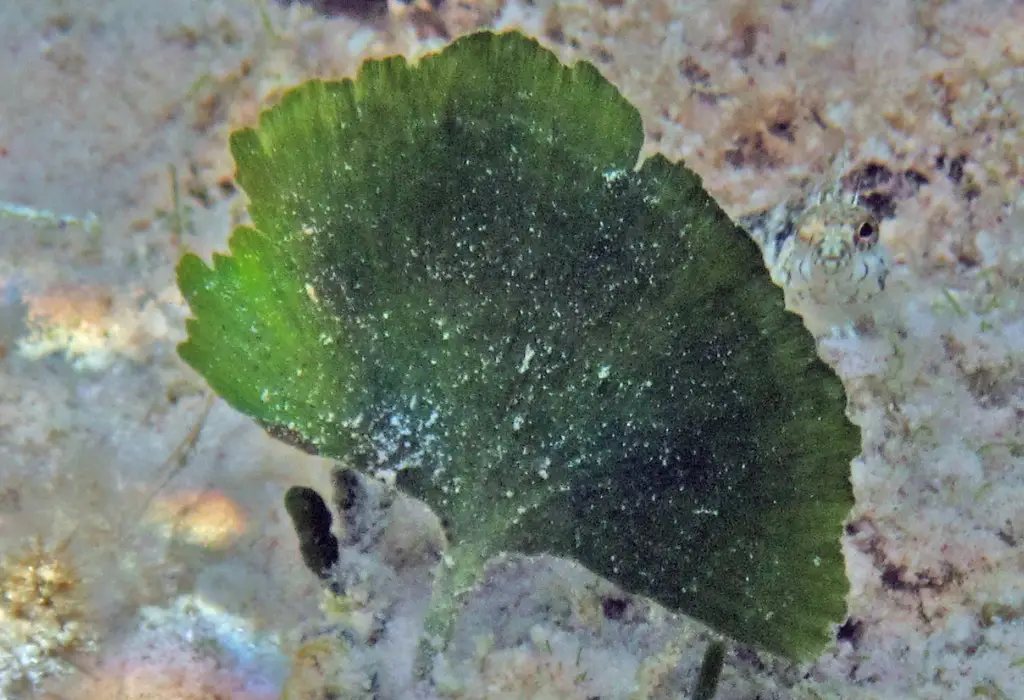
Mermaid’s fan, also known as sea fingers, is a type of green algae that is commonly found in tropical and subtropical waters around the world.
It has a unique, fan-like appearance with branches that can grow up to several centimeters in length. It is an important component of many marine ecosystems, providing habitat and shelter for a variety of marine organisms.
25. Sea Palm (Postelsia Palmaeformis)
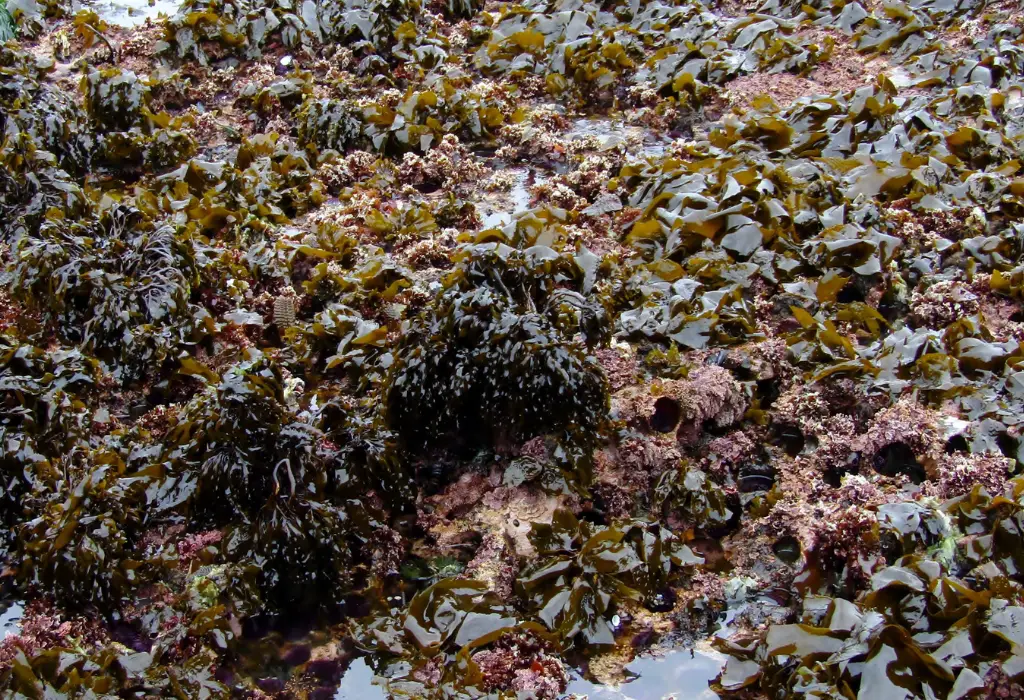
Sea palm, also known as Postelsia palmaeformis, is a species of brown algae that is native to the rocky shores of the Pacific Northwest. It is named for its palm-like appearance, with a long, narrow stipe and a fan-shaped blade at the top.
The stipe can grow up to 60 centimeters long, and the blade can be up to 30 centimeters wide. Sea palm is a hardy species that is adapted to the harsh conditions of the intertidal zone.
It can survive exposure to air and extreme temperatures, and is able to withstand the strong currents and waves that are common in its habitat. The plant’s holdfast, which anchors it to the rocky substrate, is particularly strong and can withstand forces of up to 80 kilograms per square meter.
Sea palm provides important habitat and shelter for a variety of marine organisms, including sea stars, crabs, and sea urchins. It is also a popular ingredient in many types of cuisine, particularly in Japan, where it is known as “mokurame.”
26. Sea Lettuce (Ulva Lactuca)
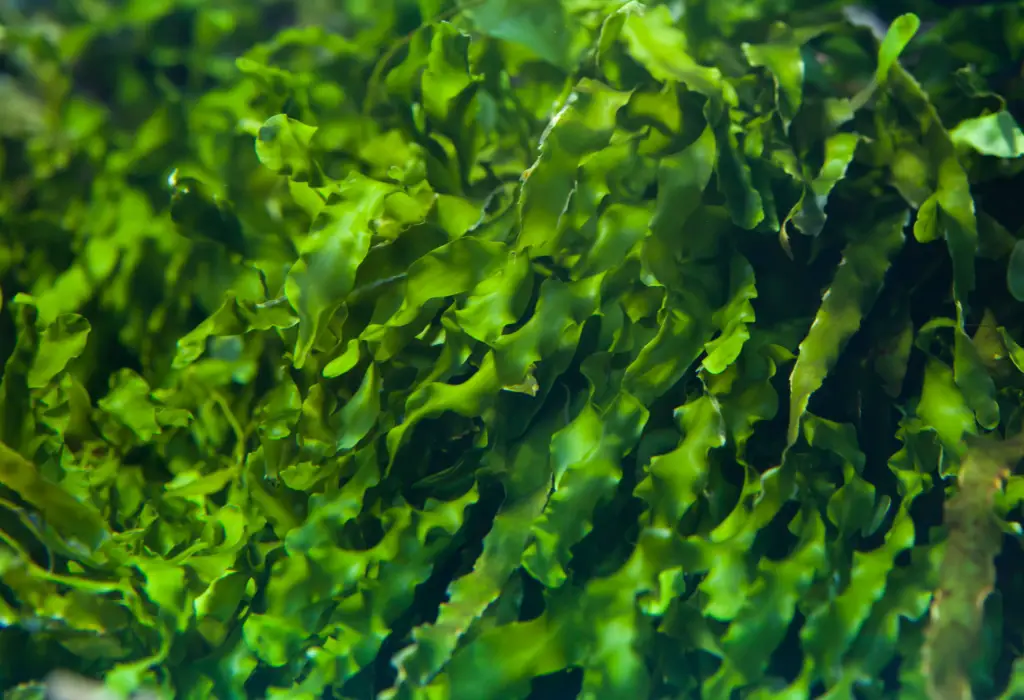
Sea lettuce, also known as Ulva lactuca, is a species of green algae that is found in coastal waters around the world. It is a bright green color and thin, sheet-like algae that can grow up to 30 centimeters long and is typically found growing on rocks or other hard substrates in the intertidal zone.
Sea lettuce is an important food source for a variety of marine organisms, including sea urchins, snails, sea turtles, fish, and crabs. It is also sometimes used as a food source for humans, particularly in Asian cuisine. In addition, sea lettuce plays an important role in the marine ecosystem by helping to maintain water quality and providing habitat for small marine animals.
Ulva is also utilized by humans in a variety of products, including fertilizer, food, and biofuel.
However, sea lettuce can also become a nuisance in areas where it grows in large quantities, particularly in areas with high nutrient levels. This can lead to the formation of “green tides” or “algal blooms” which can have negative impacts on the marine environment, including the depletion of oxygen levels and the release of toxins.
27. Brown Algae (Crystosiera)
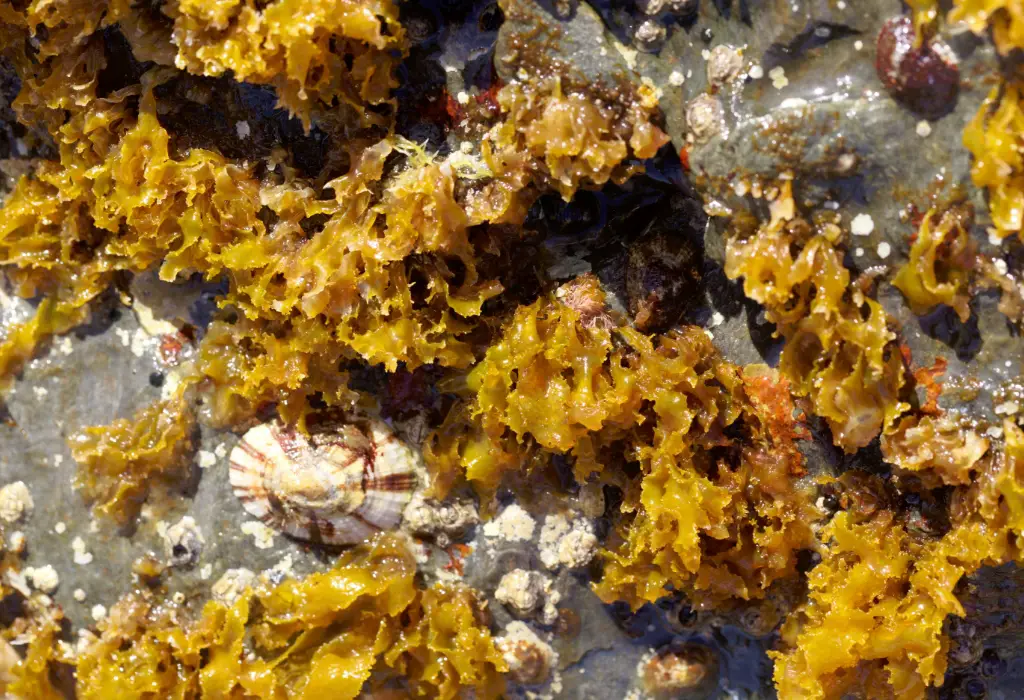
Crystosiera is a genus of brown algae that is found in rocky coastal habitats throughout the world’s oceans. This fascinating marine organism is incredibly diverse, with over 150 different species, each with unique morphological and ecological characteristics.
Crystosiera typically grows in the intertidal zone, the region of the shoreline that is exposed to air during low tide and submerged during high tide. The algae form dense mats on rocks, providing a vital habitat and food source for many marine species, such as sea urchins, snails, and crabs.
One of the most striking features of Crystosiera is its appearance. The algae are usually a dark brown or olive color, and the fronds have a feathery or bushy appearance, resembling small shrubs. The fronds are typically covered with small, button-like structures called receptacles that contain the algae’s reproductive structures.
Crystosiera is an incredibly resilient organism, with some species being able to tolerate extreme environmental conditions, such as high salinity or exposure to air for extended periods. This adaptability allows Crystosiera to thrive in a range of habitats, from sheltered rocky shores to exposed wave-swept coasts.
In addition to their ecological importance, Crystosiera species also have various uses for humans. Some species are used as a source of alginates, a type of polysaccharide that is widely used in the food industry as a thickening agent. Others are used in traditional medicine and cosmetics due to their potential antibacterial and anti-inflammatory properties.
28. Coral Reef

Coral reefs are diverse and complex ecosystems formed by the accumulation and growth of coral structures.
Coral reefs primarily exist in warm, shallow waters in the tropics and are home to a vast array of marine animals, from tiny plankton to massive sharks and whales.
Coral reefs are made up of tiny animals called coral polyps that secrete calcium carbonate, which forms the hard, skeletal structures that make up the reef. Coral reefs also serve as habitats to thousands of species of fish, invertebrates, and algae, each uniquely adapted to life in this complex environment.
29. Phytoplankton
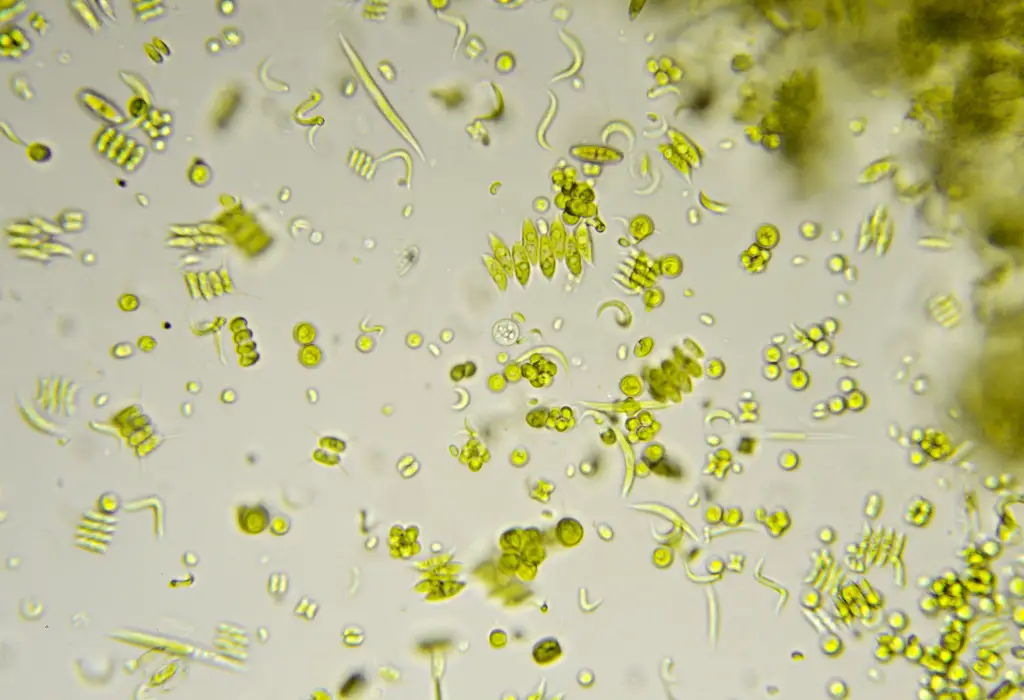
Throughout the world’s oceans, lakes, and rivers, tiny, microscopic organisms known as phytoplankton can be found. These plant-like organisms are a diverse group that can range in size from just a few microns to several millimeters.
Phytoplankton play a crucial role in the marine food chain and regulating the Earth’s climate. Through the process of photosynthesis, they are primarily responsible for producing the oxygen that we breathe, making them the largest contributors to global oxygen production.
They also serve as the base of the marine food chain, providing food and energy to a wide range of marine animals, including fish, whales, and krill. Phytoplankton are incredibly adaptable and can thrive in a wide range of environmental conditions, from the warm, sunlit surface waters to the cold, dark depths of the ocean.
They can also serve as an indicator of ecosystem health since they are highly sensitive to changes in the environment, such as changes in temperature and nutrient availability. Essential conservation efforts include reducing carbon emissions, protecting marine habitats, and promoting sustainable fishing practices, to protect and preserve these critical organisms and the ecosystems they inhabit.
30. Fire coral (Millepora)

Fire coral (Millepora) is a unique and fascinating species of marine hydrozoan that is found in tropical and subtropical waters around the world. Despite its name, fire coral is not actually a coral, but rather a type of colonial animal that belongs to the same phylum as jellyfish and sea anemones.
Fire coral is known for its striking appearance, with a bright red or orange color and a highly textured surface that resembles a coral. Its surface is covered in small, sharp, stinging nematocysts that can cause a painful burning sensation on contact, giving rise to its name.
Despite its painful sting, fire coral is an important part of many marine ecosystems. It provides a habitat for a wide range of fish and invertebrates, including clownfish, crabs, and shrimp. In addition, the sharp, stinging nematocysts that cover its surface act as a deterrent to predators, helping to protect the other organisms that live within its colony.
Fire coral is also of great interest to scientists due to its unique structure and behavior. Its colony is made up of interconnected polyps, each with a specific role in feeding, reproduction, or defense. The polyps work together to form a complex network of structures that provide a range of benefits to the colony as a whole.
Who Gave the Name of Sea Plants?
The names of sea plants, like all living things, are given by taxonomists. Taxonomy is the science of naming, describing, and classifying living organisms.
Taxonomists are scientists who specialize in this field and work to classify and name living things based on their characteristics and evolutionary relationships.
When a new species of sea plant is discovered, taxonomists will carefully examine its characteristics and compare it to other known species to determine how it should be classified and what name it should be given.
The process of naming a new species involves following a set of rules and guidelines set forth by the International Code of Nomenclature for algae, fungi, and plants.
In summary, taxonomists are responsible for giving the names of the ocean plants, as well as all other living organisms, based on their characteristics and evolutionary relationships.
Sea Plants vs Land Plants: What are the Differences?
The key differences between sea plants and land plants are shaped by the environments in which they live.
Sea plants, living in the ocean or other bodies of water, have adapted various mechanisms to thrive in their watery habitat, such as slimy or slippery surfaces and gas-filled bladders for floating.
Land plants, on the other hand, have evolved to retain water and withstand different weather conditions, using roots, stems, and leaves.
Both sea plants and land plants can reproduce sexually and asexually, but they have different reproductive methods.
Sea plants may release gametes into the water for fertilization, while land plants rely on pollinators like bees for cross-pollination.
Land plants are more diverse and have a greater number of species due to the varied and specialized terrestrial environment.
Sea plants and land plants play important roles in their respective ecosystems, such as providing habitat and absorbing carbon dioxide or preventing erosion and producing oxygen.
FAQ for Sea Plants In The Ocean
What are some common uses of sea plants?
Sea plants are used for a variety of purposes, including food, medicine, cosmetics, and industrial products.
For example, seaweed is commonly used in Asian cuisine, while carrageenan, a substance derived from red seaweed, is used as a thickener in a variety of food and cosmetic products.
How do sea plants contribute to the health of marine ecosystems?
Sea plants play a vital role in marine ecosystems by providing habitat and food for countless marine animals.
They also contribute to the health of marine ecosystems by producing oxygen through the process of photosynthesis, and by regulating the Earth’s climate through the absorption of carbon dioxide from the atmosphere.
How are sea plants adapted to life in the ocean?
Sea plants have evolved a range of adaptations to survive and thrive in the harsh and dynamic environment of the ocean.
For example, many seaweeds have evolved holdfasts, specialized structures that anchor them to rocks or other substrates in the ocean. Some sea plants also have specialized structures for buoyancy or protection from predators, such as spines or toxic compounds.
How do sea plants differ from land plants?
Sea plants differ from land plants in a number of ways. For example, sea plants lack roots, stems, and leaves, and instead have specialized structures for attaching themselves to rocks or other substrates in the ocean.
They also have adaptations to survive in the saltwater environment of the ocean, such as specialized structures for osmoregulation and the ability to tolerate high levels of salinity.
How can we help protect sea plants and their ecosystems?
There are many ways that we can help protect sea plants and their ecosystems, such as reducing our use of plastic, supporting sustainable seafood practices, and advocating for marine conservation policies.
We can also reduce our carbon footprint and support efforts to mitigate climate change, which is a major threat to the health and survival of sea plants and marine ecosystems.
Conclusion for Sea Plants In The Ocean
The ocean is home to an incredible diversity of plant life, each with its unique adaptations and ecological roles.
From the microscopic to the towering, sea plants play a crucial role in marine ecosystems, providing habitat and food for countless marine animals and regulating the Earth’s climate through the process of photosynthesis.
The sea plants on this list represent just a fraction of the amazing diversity of life that calls the ocean home.
We hope that by exploring these fascinating sea plants, you have gained a greater appreciation for the complex and beautiful world of the ocean and the important role that sea plants play in sustaining life on our planet.
So, how many names of ocean plants do you remember by now?
Read More:
